THM Response in the Near Field of an HLW Disposal Tunnel in the Callovo-Oxfordian Clay Host Rock Caused by the Imposed Heat Flux at Different Water Drainage Conditions
Abstract
:1. Introduction
2. Methodology
- Isotropic case: isotropic stress state and isotropic material properties;
- Anisotropic case: anisotropic stress state and anisotropic material properties.
2.1. Mathematical Model
2.2. Numerical Model
Geometry and Discretization
2.3. Initial and Boundary Conditions
- excavation (duration of 1 day)
- waiting phase (1–180 days)
- heating phase (180–3650 days (10 years))
2.4. Input Parameters
3. Results and Discussion
3.1. Heating under Drained Conditions
3.1.1. Thermal State
3.1.2. Hydraulic Response
3.1.3. Mechanical Response
3.2. Heating under Undrained Conditions
3.2.1. Thermal State
3.2.2. Hydraulic Response
3.2.3. Mechanical Response
4. Conclusions
- The anisotropy in stress and properties had an impact on the hydro-mechanical response of the material even during the excavation and waiting phases.
- Because of anisotropy, the temperature at the tunnel boundary was higher by 4 degrees of Celsius.
- The water drainage condition on the tunnel boundary had no effect on the thermal state around the tunnel; however, it had a significant impact on the hydro-mechanical response.
- For heating under undrained conditions, the regions with the tensile stress state were predicted for the isotropic case as well for anisotropic conditions and properties. The potential for the regions with the tensile stress state was observed near the tunnel wall, but not 1.5 times the tunnel radius away.
- If undrained conditions will prevail in the repository and the heat load will be of a similar magnitude, the tensile fracture development conditions should be investigated further.
- As for the interpretation of in-situ experimental results via simulations, attention should be paid to the proper representation of real hydraulic conditions in the future numerical model.
- The present modeling results will serve for further investigation into the COx clay behavior under elevated temperature conditions.
Author Contributions
Funding
Data Availability Statement
Conflicts of Interest
References
- Licence Granted for Finnish Used Fuel Repository. 2015. Available online: https://www.world-nuclear-news.org/WR-Licence-granted-for-Finnish-used-fuel-repository-1211155.html (accessed on 1 June 2022).
- Posiva Submits Application for Operating Licence for Encapsulation and Final Disposal Facility of Spent Nuclear Fuel. 2021. Available online: https://www.posivasolutions.com/news/pressreleasesstockexchangereleases/2021/posivasubmitsapplicationforoperatinglicenceforencapsulationandfinaldisposalfacilityofspentnuclearfuel.html (accessed on 1 June 2022).
- Swedish Government Approves SKB’s Final Repository System. Available online: https://www.neimagazine.com/news/newsswedish-government-approves-skbs-final-repository-system-9448895 (accessed on 2 June 2022).
- Vu, M.-N.; Armand, G.; Plua, C. Thermal Pressurization Coefficient of Anisotropic Elastic Porous Media. Rock Mech. Rock Eng. 2020, 53, 2027–2031. [Google Scholar] [CrossRef]
- Guo, R.; Thatcher, K.; Seyedi, D.; Plúa, C. Calibration of the thermo-hydro-mechanical parameters of the Callovo-Oxfordian claystone and the modelling of the ALC experiment. Int. J. Rock Mech. Min. Sci. 2020, 132, 104351. [Google Scholar] [CrossRef]
- Armand, G.; Bumbieler, F.; Conil, N.; de La Vaissière Bosgiraud, J.M.; Vu, M.N. Main outcomes from in situ THM experiments programme to demonstrate feasibility of radioactive HL-ILW disposal in the Callovo–Oxfordian claystone. J. Rock Mech. Geotech. Eng. 2017, 9, 415–427. [Google Scholar] [CrossRef]
- Braun, P.; Ghabezloo, S.; Delage, P.; Sulem, J.; Conil, N. Transversely Isotropic Poroelastic Behaviour of the Callovo-Oxfordian Claystone: A Set of Stress-Dependent Parameters. Rock Mech. Rock Eng. 2021, 54, 377–396. [Google Scholar] [CrossRef]
- Armand, G.; Conil, N.; Talandier, J.; Seyedi, D. Fundamental aspects of the hydromechanical behaviour of Callovo-Oxfordian claystone: From experimental studies to model calibration and validation. Comput. Geotech. 2017, 85, 277–286. [Google Scholar] [CrossRef]
- Braun, P.; Delage, P.; Ghabezloo, S.; Baptiste, C.; Conil, N.; Vu, M. Inducing Tensile Failure of Claystone Through Thermal Pressurization in a Novel Triaxial Device. Rock Mech. Rock Eng. 2022, 55, 3881–3899. [Google Scholar] [CrossRef]
- Vu, M.; Souley, M.; Alonso, M.; Vaunat, J.; Gens, A.; Plúa, C.; De Lesquen, C.; Armand, G. Creep Effects on the Thermo-Hydro-Mechanical Responses of Callovo-Oxfordian Claystone. In Challenges and Innovations in Geomechanics; Barla, M., Di Donna, A., Sterpi, D., Eds.; Springer: Cham, Switzerland, 2021; Volume 125. [Google Scholar] [CrossRef]
- De Lesquen, C.; Vu, M.N.; Simo, E.; Besuelle, P.; Raude, S.; Dizier, A.; Narkuniene, A.; Reinicke, A.; Collin, F.; Gens, A. Final modelling report on effect of temperature on near field properties. 2020. Second version as of 02.07.2021 of deliverable D7.6 of the HORIZON 2020 project EURAD. EC Grant agreement no: 847593.
- Thatcher, K.; Bond, A.; Norris, S. Pore pressure response to disposal of heat generating radioactive waste in a low permeability host rock. Int. J. Rock Mech. Min. Sci. 2020, 135, 104456. [Google Scholar] [CrossRef]
- Xu, H.; Rutqvist, J.; Plúa, C.; Armand, G.; Birkholzer, J. Modeling of thermal pressurization in tight claystone using sequential THM coupling: Benchmarking and validation against in-situ heating experiments in COx claystone. Tunn. Undergr. Space Technol. 2020, 103, 103428. [Google Scholar] [CrossRef]
- Seyedi, D.; Plúa, C.; Vitel, M.; Armand, G.; Rutqvist, J.; Birkholzer, J.; Xu, H.; Guo, R.; Thatcher, K.; Bond, A.; et al. Upscaling THM modeling from small-scale to full-scale in-situ experiments in the Callovo-Oxfordian claystone. Int. J. Rock Mech. Min. Sci. 2021, 144, 104582. [Google Scholar] [CrossRef]
- Garitte, B.; Nguyen, T.S.; Barnichon, J.; Graupner, B.; Lee, C.; Maekawa, K.; Manepally, C.; Ofoegbu, G.; Dasgupta, B.; Fedors, R.; et al. Modelling the Mont Terri HE-D experiment for the Thermal–Hydraulic–Mechanical response of a bedded argillaceous formation to heating. Environ. Earth Sci. 2017, 76, 345. [Google Scholar] [CrossRef]
- Wang, W.; Shao, H.; Nagel, T.; Kolditz, O. Analysis of coupled thermal-hydro-mechanical processes during small scale in situ heater experiment in Callovo-Oxfordian clay rock introducing a failure-index permeability model. Int. J. Rock Mech. Min. Sci. 2021, 142, 104683. [Google Scholar] [CrossRef]
- Bumbieler, F.; Plúa, C.; Tourchi, S.; Vu, M.; Vaunat, J.; Gens, A.; Armand, G. Feasibility of constructing a full-scale radioactive high-level waste disposal cell and characterization of its thermo-hydro-mechanical behavior. Int. J. Rock Mech. Min. Sci. 2021, 137, 104555. [Google Scholar] [CrossRef]
- Conil, N.; Vitel, M.; Plúa, C.; Vu, M.; Seyedi, D.; Armand, G. In Situ Investigation of the THM Behavior of the Callovo-Oxfordian Claystone. Rock Mech. Rock Eng. 2020, 53, 2747–2769. [Google Scholar] [CrossRef]
- Tourchi, S.; Vaunat, J.; Gens, A.; Bumbieler, F.; Vu, M.; Armand, G. A full-scale in situ heating test in Callovo-Oxfordian claystone: Observations, analysis and interpretation. Comput. Geotech. 2021, 133, 104045. [Google Scholar] [CrossRef]
- Wang, W.; Shao, H.; Rink, K.; Fischer, T.; Kolditz, O.; Nagel, T. Analysis of coupled thermal-hydro-mechanical processes in Callovo-Oxfordian clay rock: From full-scale experiments to the repository scale. Eng. Geol. 2021, 293, 106265. [Google Scholar] [CrossRef]
- Yuan, Y.; Xu, T.; Gherardi, F.; Lei, H. Thermo-Hydro-Mechanical Coupled Modeling of In-Situ Behavior of the Full-Scale Heating Test in the Callovo-Oxfordian Claystone. Energies 2022, 15, 4089. [Google Scholar] [CrossRef]
- Seyedi, D.M.; Armand, G.; Noiret, A. “Transverse Action”—A model benchmark exercise for numerical analysis of the Callovo-Oxfordian claystone hydromechanical response to excavation operations. Comput. Geotech. 2017, 85, 287–305. [Google Scholar] [CrossRef]
- Xu, H.; Rutqvist, J.; Birkholzer, J. A study of thermal pressurization and potential for hydro-fracturing associated with nuclear waste disposal in argillaceous claystone. Int. J. Rock Mech. Min. Sci. 2020, 136, 104536. [Google Scholar] [CrossRef]
- Guo, R.; Xu, H.; Plúa, C.; Armand, G. Prediction of the thermal-hydraulic-mechanical response of a geological repository at large scale and sensitivity analyses. Int. J. Rock Mech. Min. Sci. 2020, 136, 104484. [Google Scholar] [CrossRef]
- Plúa, C.; Vu, M.; Armand, G.; Rutqvist, J.; Birkholzer, J.; Xu, H.; Guo, R.; Thatcher, K.; Bond, A.; Wang, W.; et al. A reliable numerical analysis for large-scale modelling of a high-level radioactive waste repository in the Callovo-Oxfordian claystone. Int. J. Rock Mech. Min. Sci. 2021, 140, 104574. [Google Scholar] [CrossRef]
- Thatcher, K.; Bond, A.; Norris, S. Assessing the hydraulic and mechanical impacts of heat generating radioactive waste at the whole repository scale. Int. J. Rock Mech. Min. Sci. 2021, 138, 104576. [Google Scholar] [CrossRef]
- Pardoen, B.; Collin, F. Modelling the influence of strain localisation and viscosity on the behaviour of underground drifts drilled in claystone. Comput. Geotech. 2017, 85, 351–367. [Google Scholar] [CrossRef]
- Plúa, C.; Vu, M.; Seyedi, D.; Armand, G. Effects of inherent spatial variability of rock properties on the thermo-hydro-mechanical responses of a high-level radioactive waste repository. Int. J. Rock Mech. Min. Sci. 2021, 145, 104682. [Google Scholar] [CrossRef]
- Cuvilliez, S.; Djouadi, I.; Raude, S.; Fernandes, R. An elastoviscoplastic constitutive model for geomaterials: Application to hydromechanical modelling of claystone response to drift excavation. Comput. Geotech. 2017, 85, 321–340. [Google Scholar] [CrossRef]
- Mánica, M.; Gens, A.; Vaunat, J.; Ruiz, D.F. A time-dependent anisotropic model for argillaceous rocks. Application to an underground excavation in Callovo-Oxfordian claystone. Comput. Geotech. 2017, 85, 341–350. [Google Scholar] [CrossRef]
- Mánica, M.; Gens, A.; Vaunat, J.; Armand, G.; Vu, M. Numerical simulation of underground excavations in an indurated clay using non-local regularisation. Part 1: Formulation and base case. Géotechnique 2021, 1–21. [Google Scholar] [CrossRef]
- Yu, Z.; Shao, J.; Duveau, G.; Vu, M.; Armand, G. Numerical modeling of deformation and damage around underground excavation by phase-field method with hydromechanical coupling. Comput. Geotech. 2021, 138, 104369. [Google Scholar] [CrossRef]
- Zhao, J.J.; Shen, W.Q.; Shao, J.F.; Liu, Z.B.; Vu, M.N. A constitutive model for anisotropic clay-rich rocks considering micro-structural composition. Int. J. Rock Mech. Min. Sci. 2022, 151, 105029. [Google Scholar] [CrossRef]
- Rutqvist, J.; Börgesson, L.; Chijimatsu, M.; Kobayashi, A.; Jing, L.; Nguyen, T.S.; Noorishad, J.; Tsang, C.-F. Thermohydromechanics of partially saturated geological media: Governing equations and formulation of four finite element models. Int. J. Rock Mech. Min. Sci. 2001, 38, 105–127. [Google Scholar] [CrossRef]
- Villar, M.V.; Armand, G.; Conil, N.; de Lesquen, C.; Herold, P.; Simo, E.; Mayor, J.C.; Dizier, A.; Li, X.; Chen, G.; et al. D7.1 HITEC. Initial State-of-the-Art on THM Behaviour of (i) Buffer Clay Materials and of (ii) Host Clay Materials. Deliverable D7.1 HITEC. EURAD Project, Horizon 2020 No 847593. p. 214. Available online: https://www.ejp-eurad.eu/publications/eurad-d71-initial-sota-thm-behaviour-i-buffer-clay-materials-and-ii-host-clay (accessed on 1 June 2022).
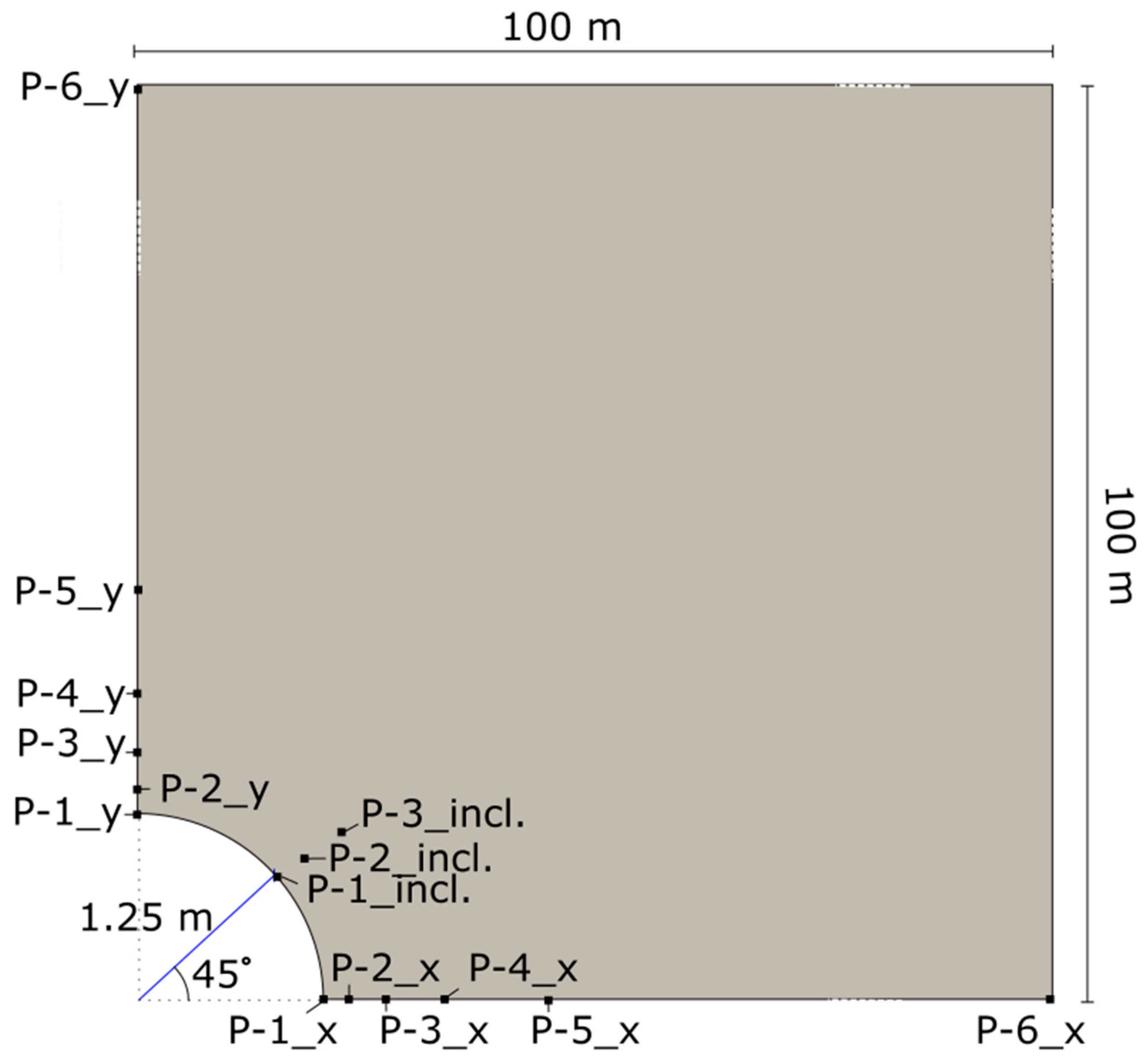
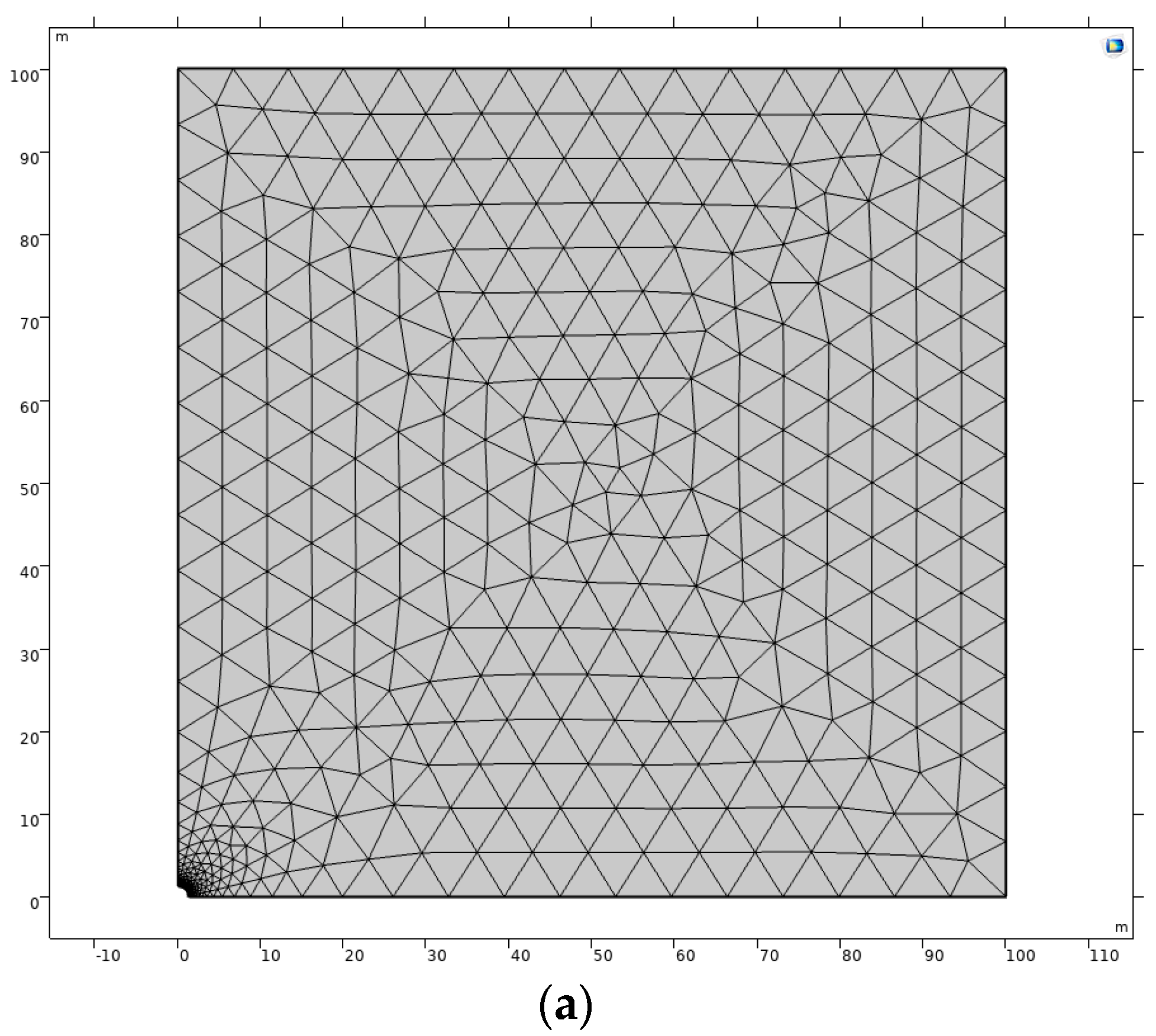
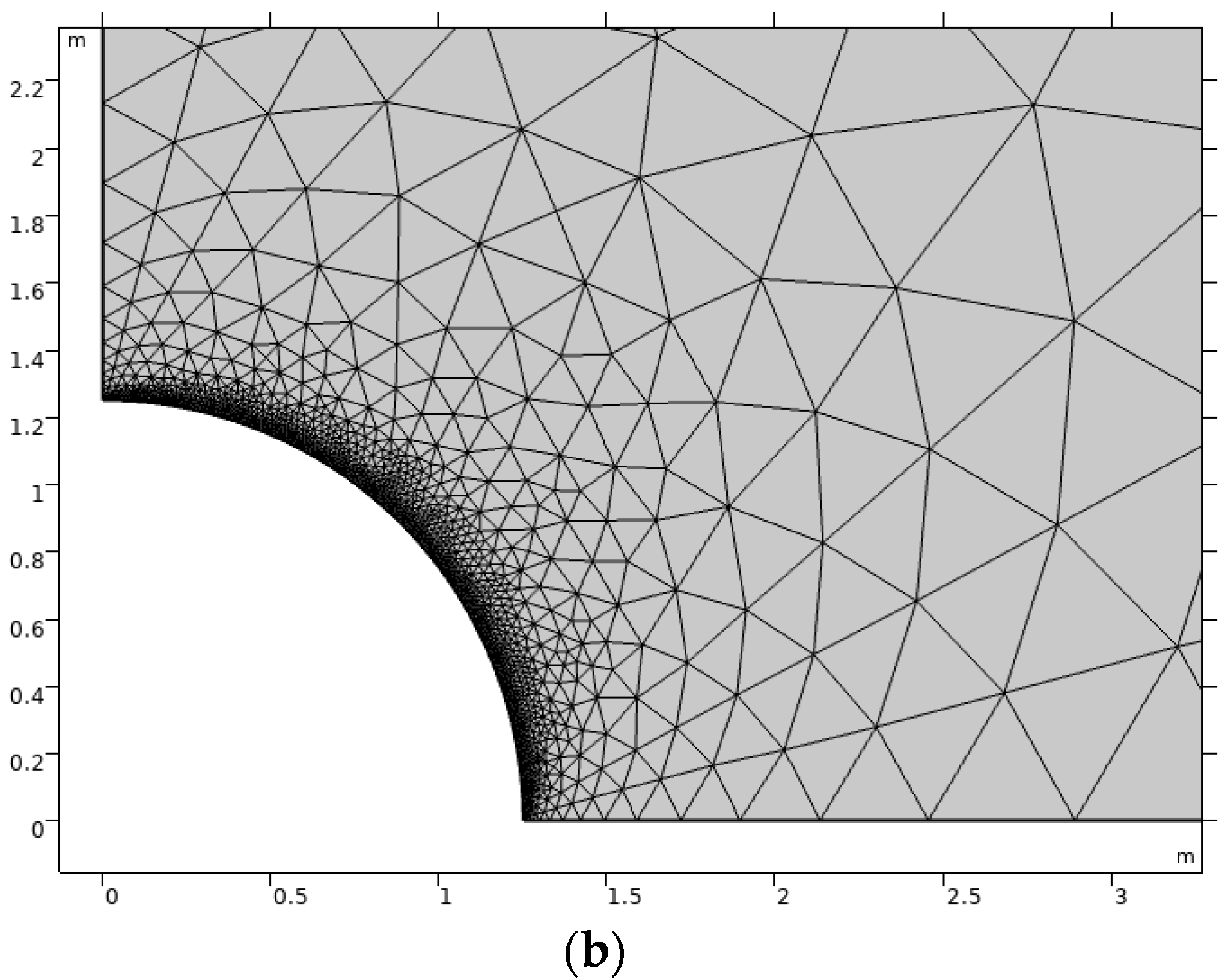
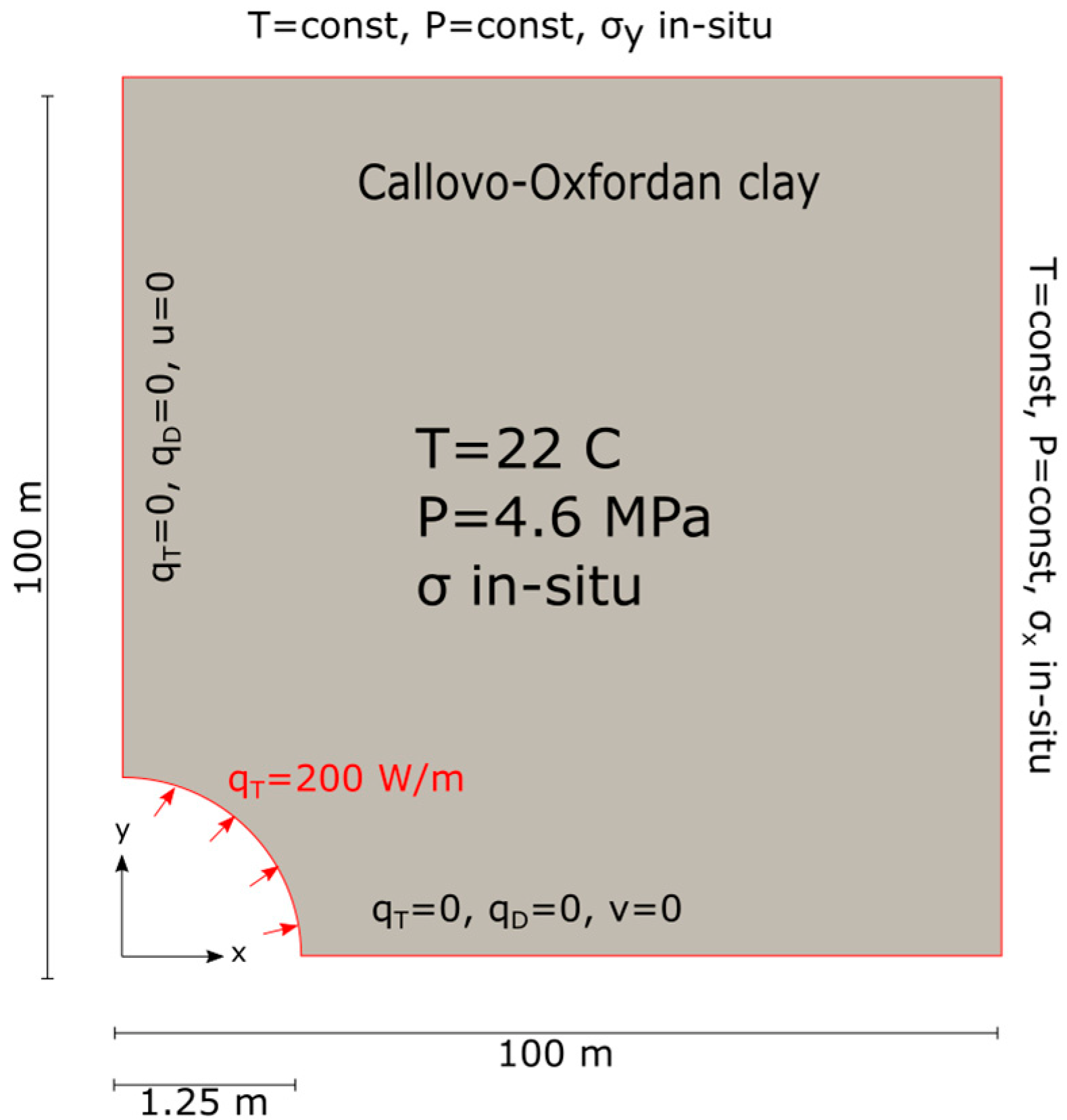
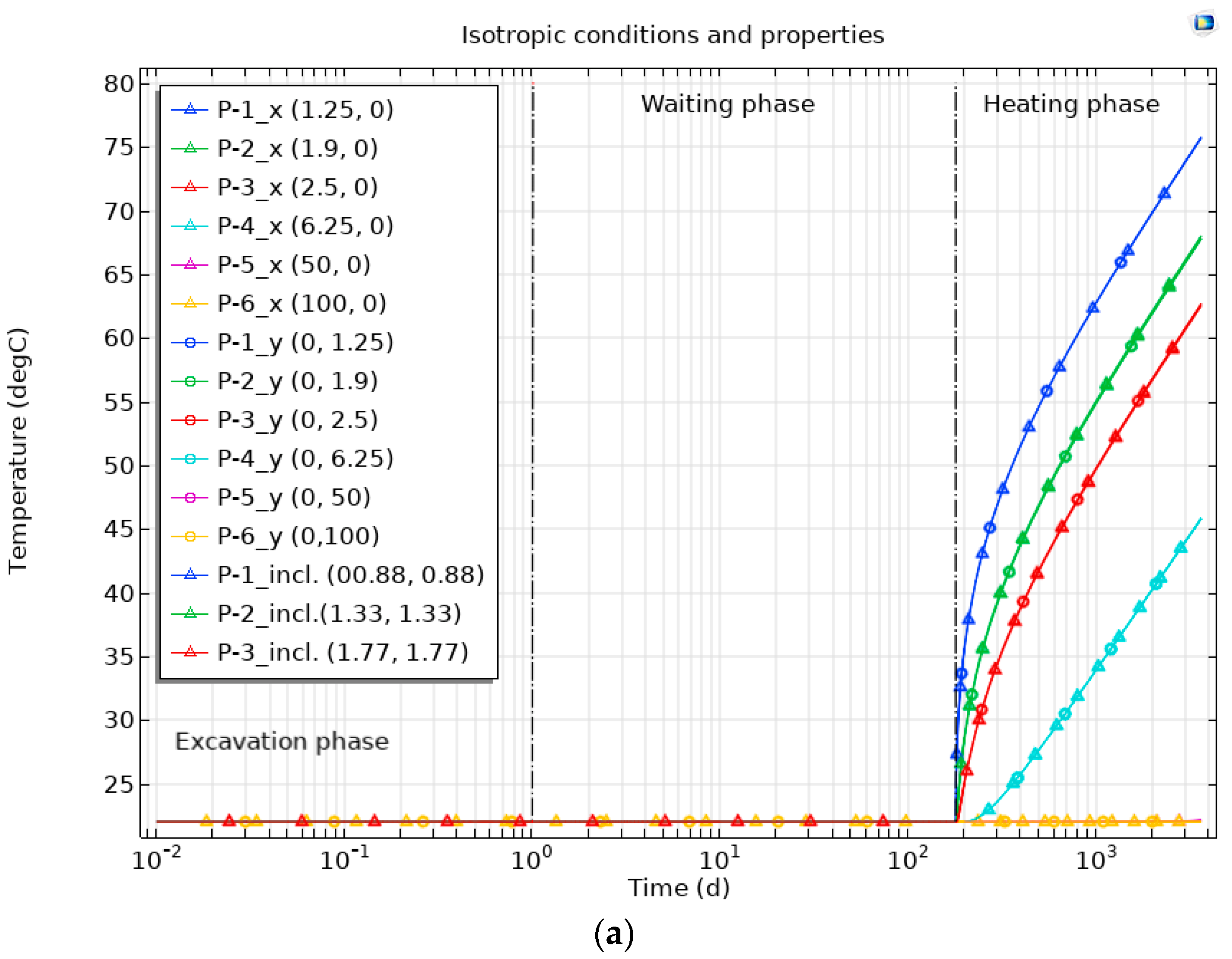

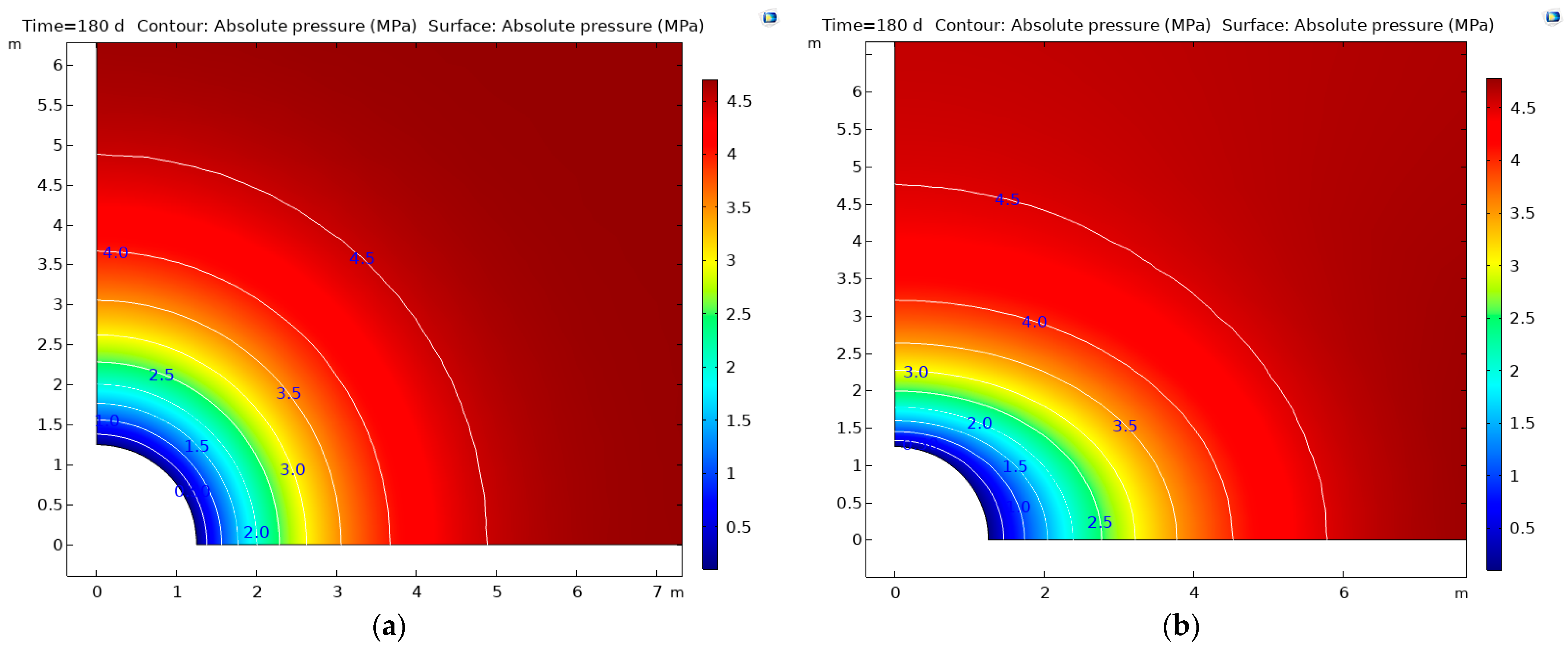
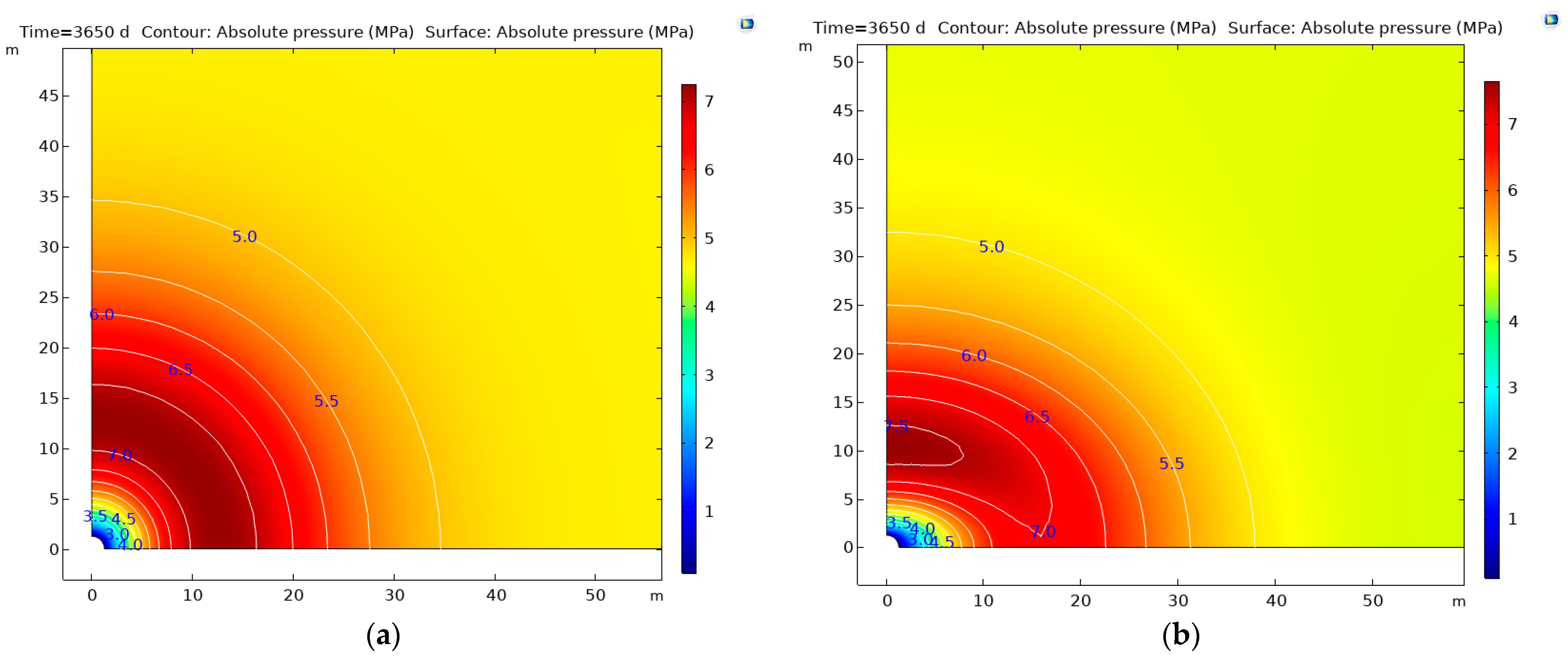
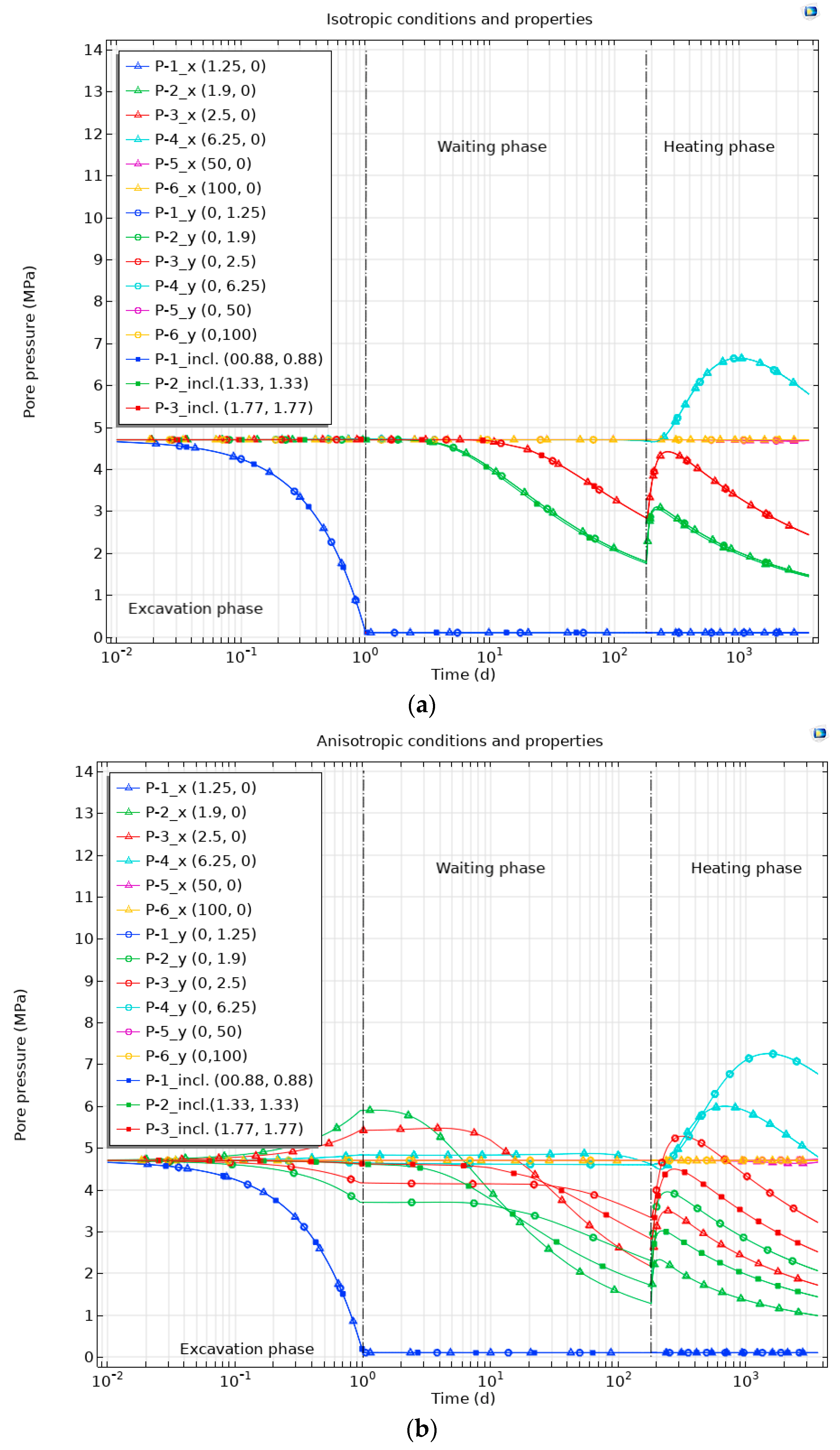

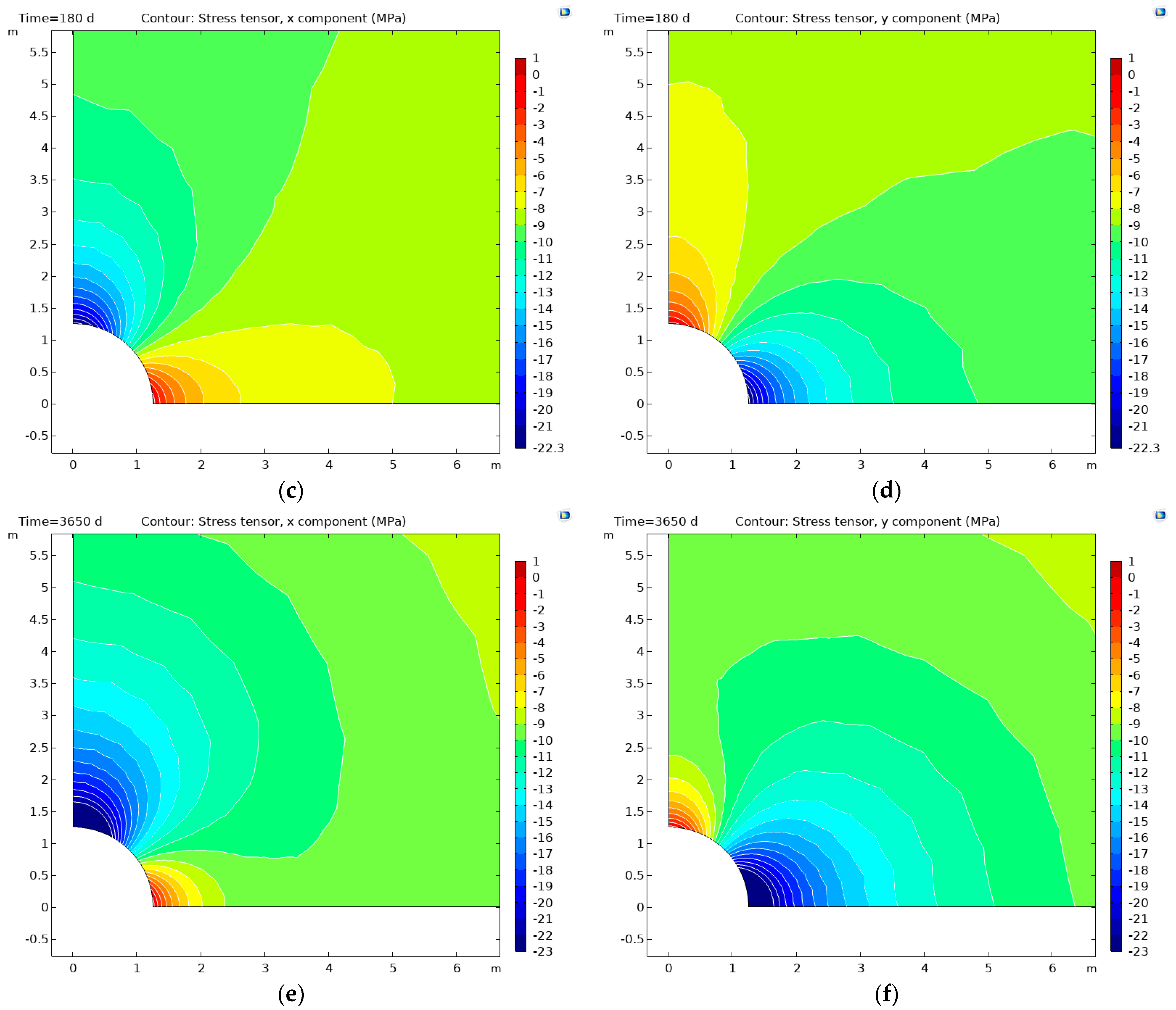
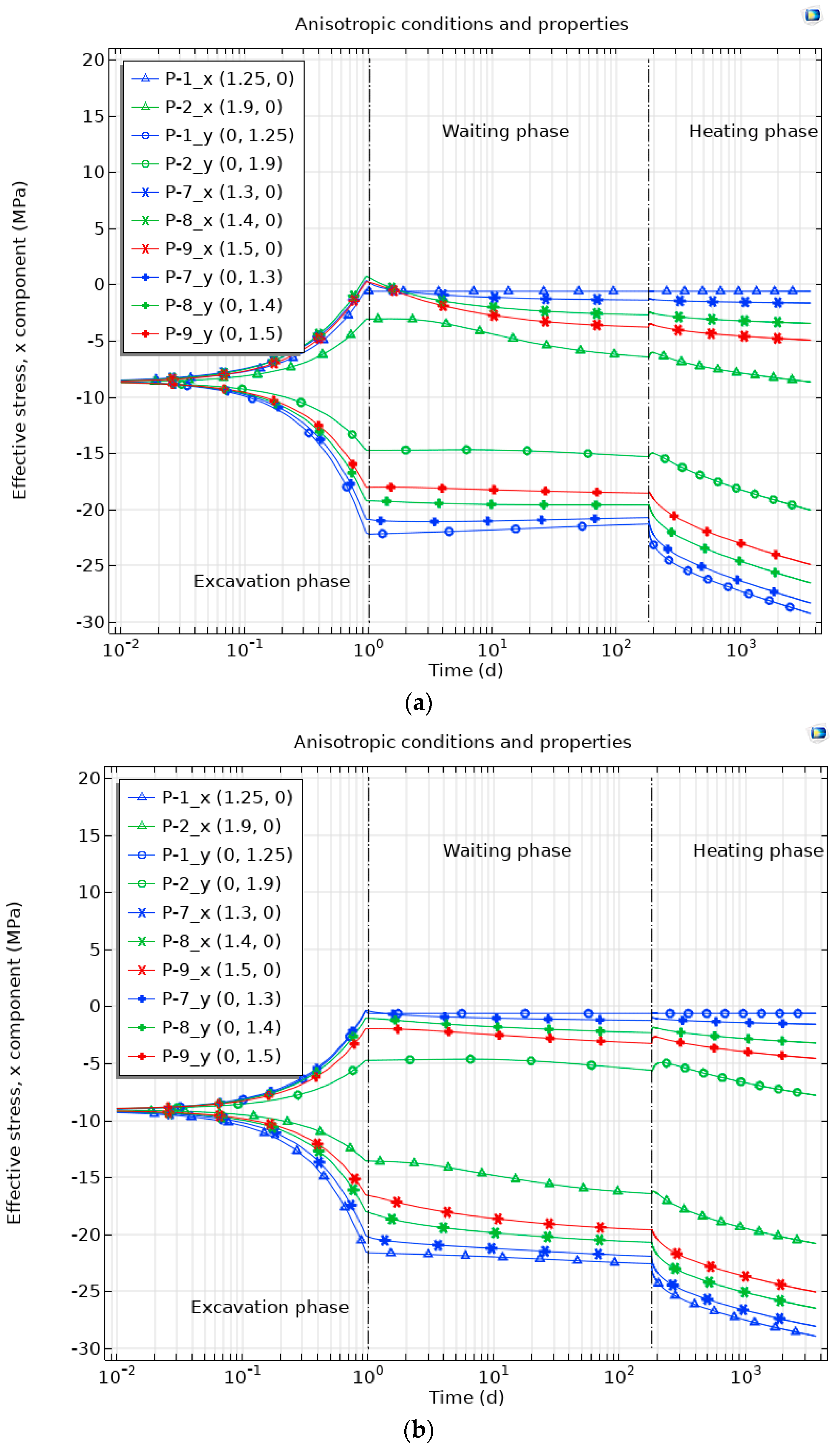

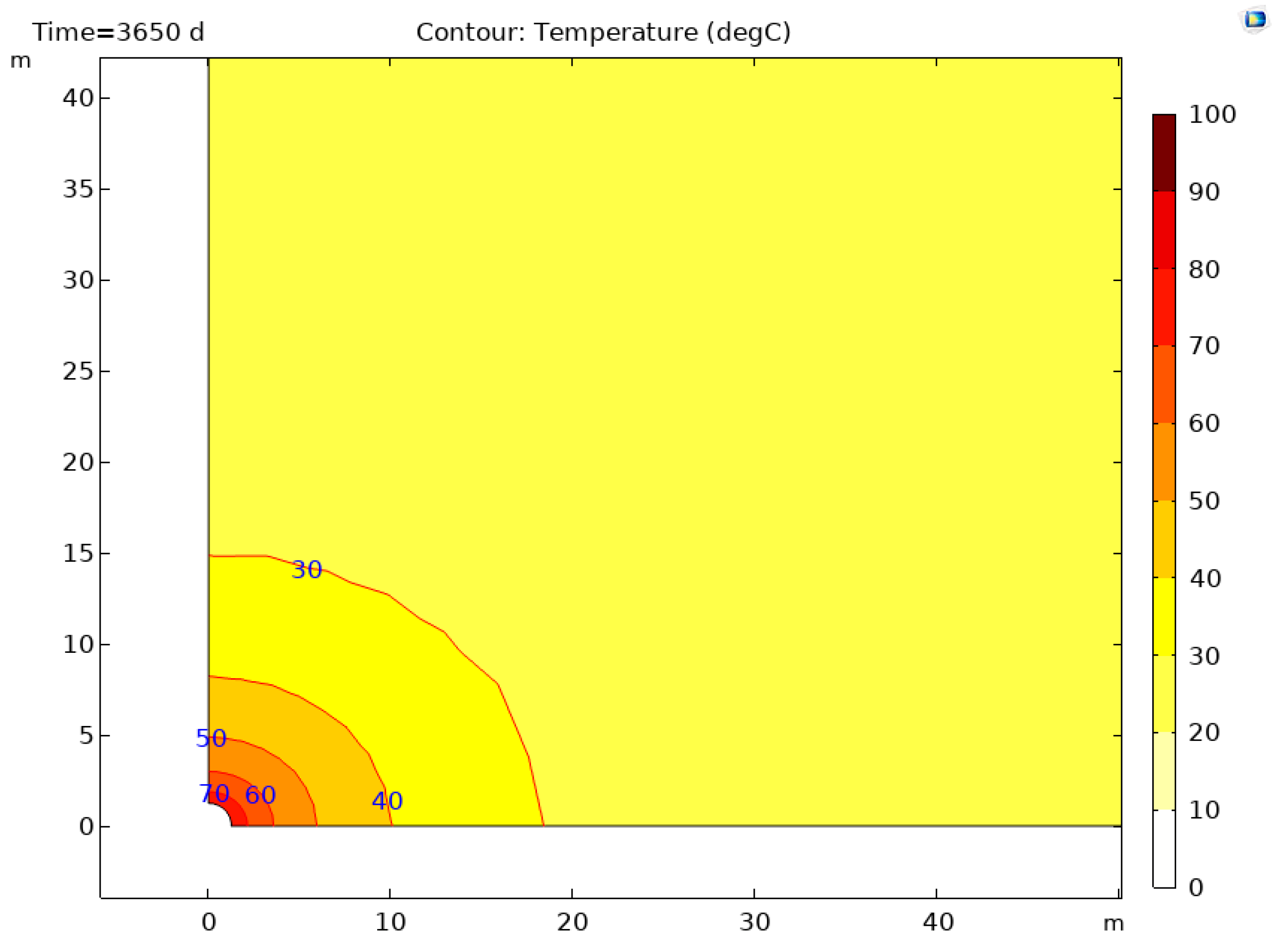
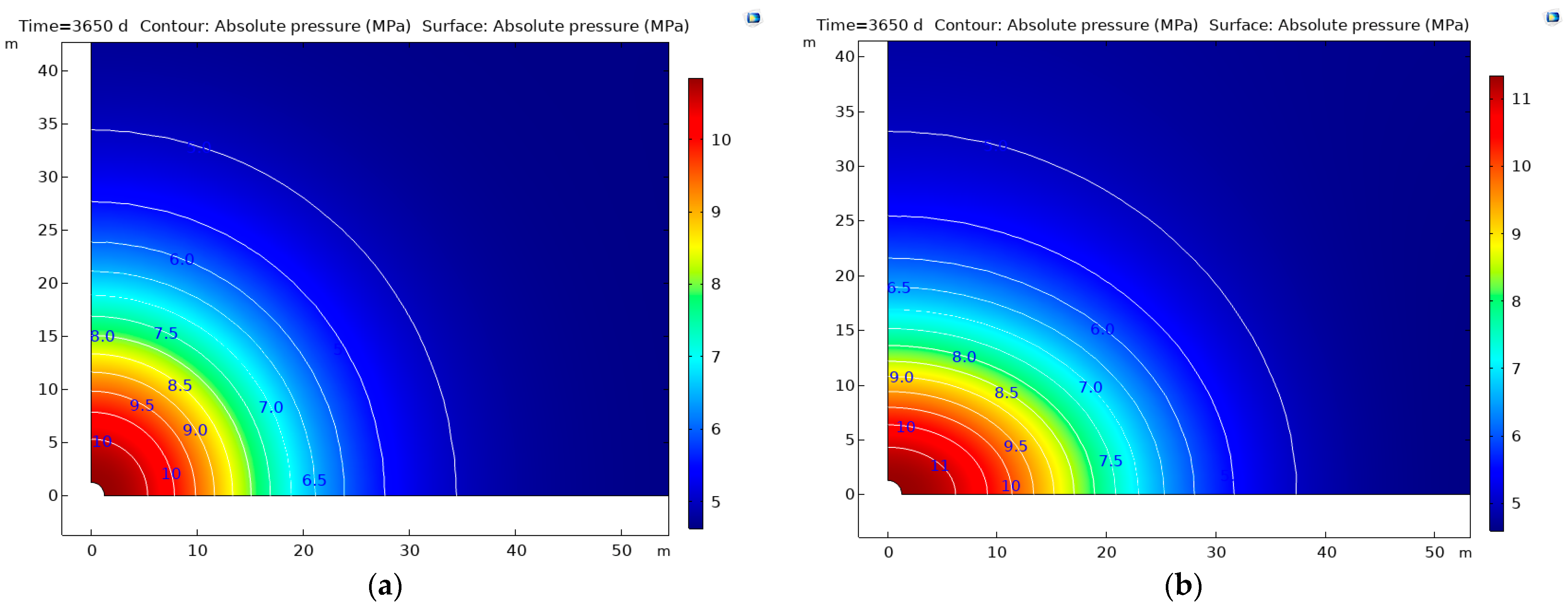

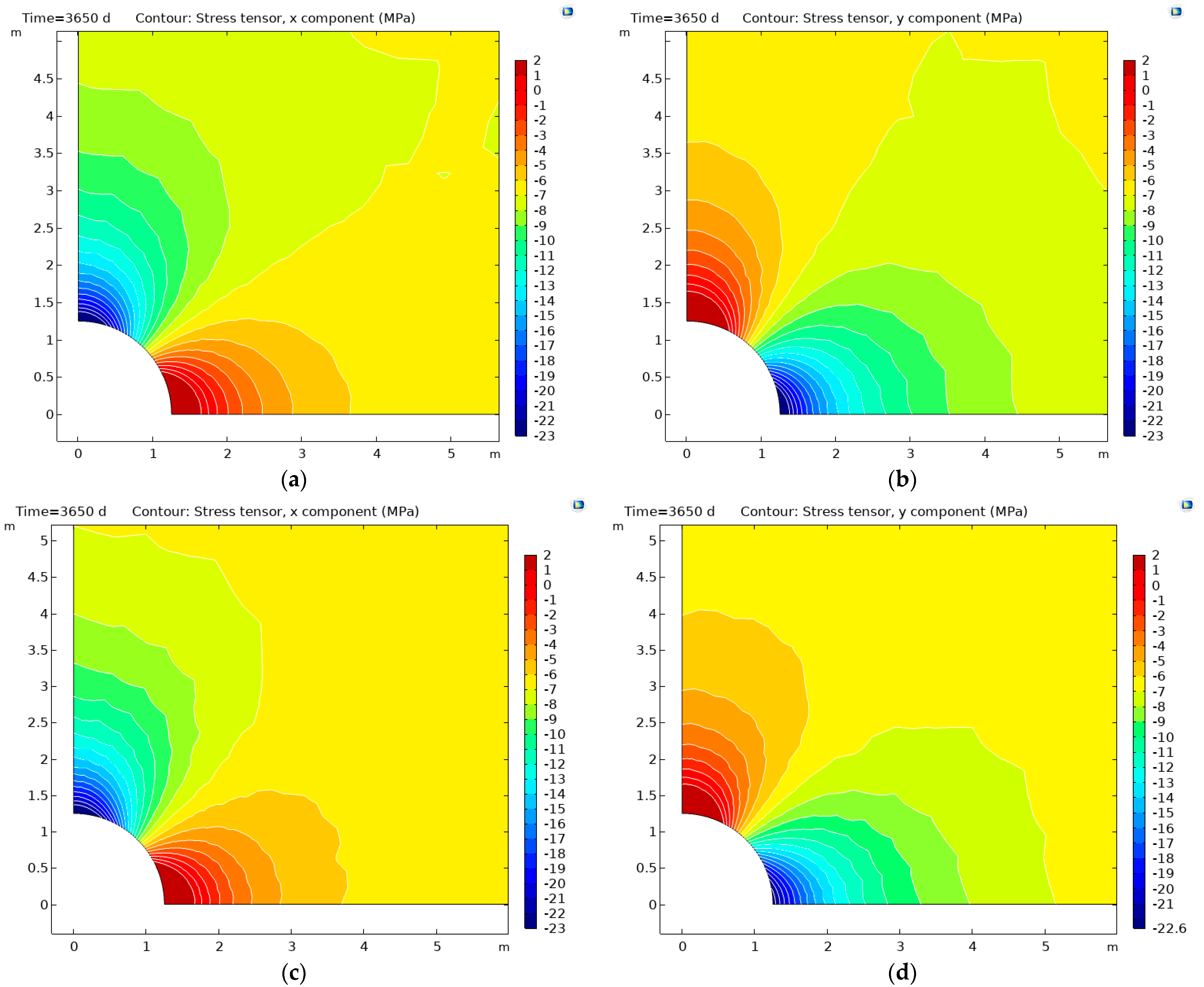
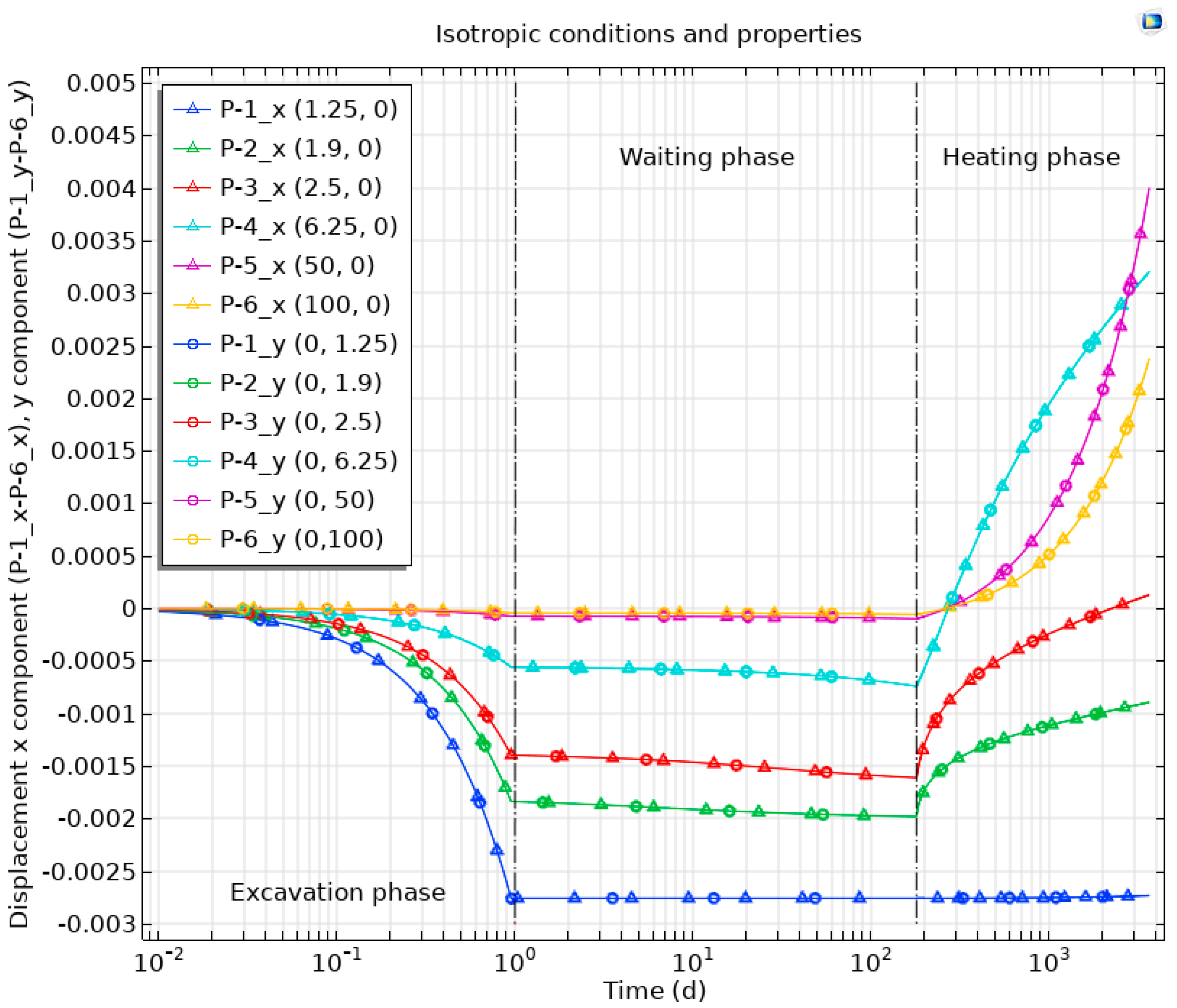
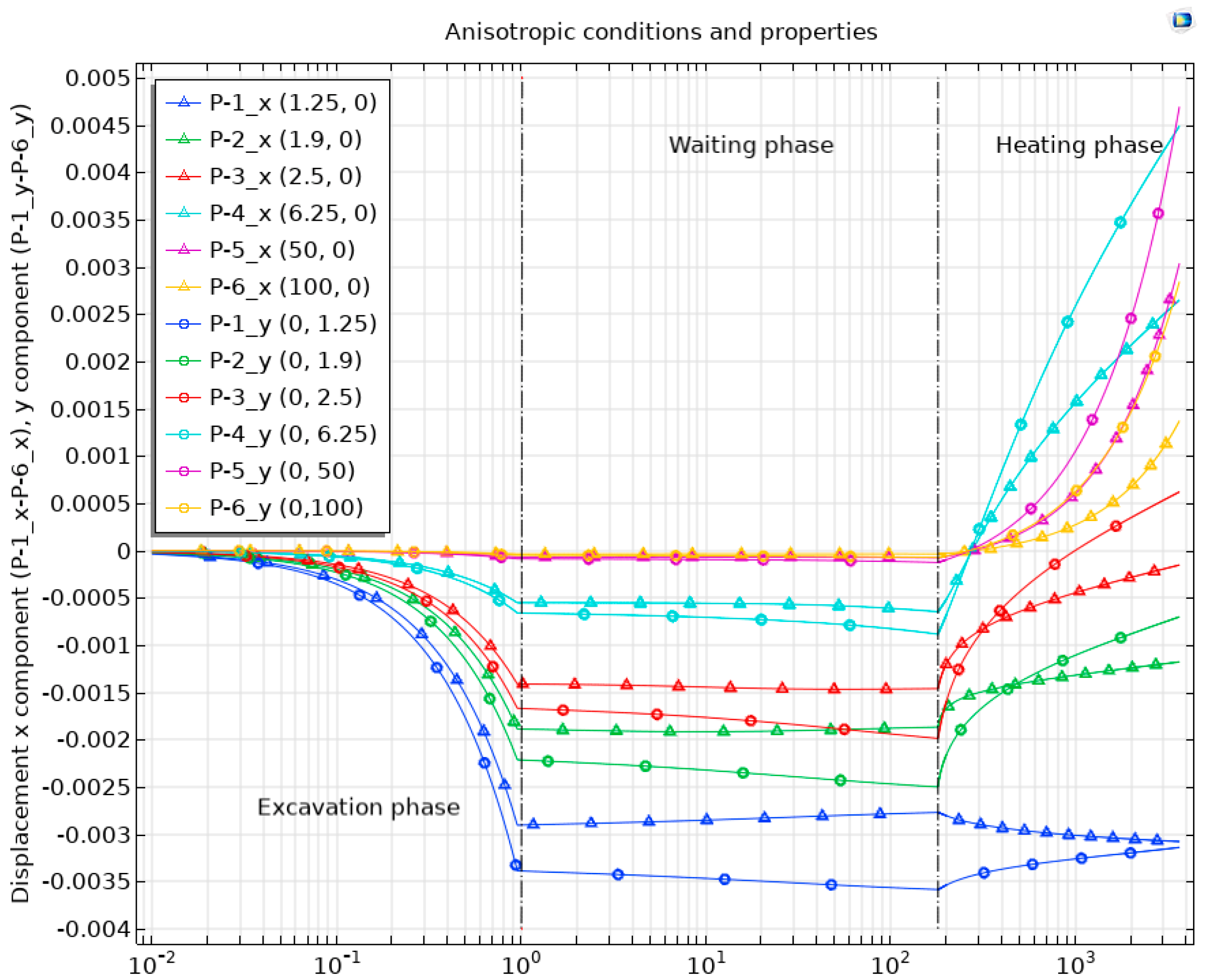
| Observation Points | Coordinates x, y, (m) | Distance from Tunnel Wall (R = 1.25 m + Distance in m (Direction)) |
|---|---|---|
| Main points | ||
| P-1_x | x = 1.25, y = 0.00 | R + 0.00 (horiz.) |
| P-2_x | x = 1.90, y = 0.00 | R + 0.65 (horiz.) |
| P-3_x | x = 2.50, y = 0.00 | R + 1.25 (horiz.) |
| P-4_x | x = 6.25, y = 0.00 | R + 5.00 (horiz.) |
| P-5_x | x = 50.00, y = 0.00 | R + 48.75 (horiz.) |
| P-6_x | x = 100.00, y = 0.00 | R + 98.75 (horiz.) |
| P-1_y | x = 0.00, y = 1.25 | R + 0.00 (vert.) |
| P-2_y | x = 0.00, 1.90) | R + 0.65 (vert.) |
| P-3_y | x = 0.00, 2.50) | R + 1.25 (vert.) |
| P-4_y | x= 0.00, y = 6.25) | R + 5.00 (vert.) |
| P-5_y | x = 0.00, y = 50.00) | R + 48.75 (vert.) |
| P-6_y | x = 0.00, y = 100.00) | R + 98.75 (vert.) |
| Auxiliary points | ||
| P-1_incl. | x = 0.88, y = 0.88) | R + 0.00 (45 deg.) |
| P-2_incl. | x = 1.33, y = 1.33) | R + 0.65 (45 deg.) |
| P-3_incl. | x = 1.77, y = 1.77) | R + 1.25 (45 deg.) |
| P-7_x | x = 1.30, y = 0.00) | R + 0.05 (horiz.) |
| P-8_x | x = 1.40, y = 0.00) | R + 0.15 (horiz.) |
| P-9_x | x = 1.50, y = 0.00) | R + 1.25 (horiz.) |
| P-7_y | x = 0.00, y = 1.30) | R + 0.05 (vert.) |
| P-8_y | x = 0.00, y = 1.40) | R + 0.15 (vert.) |
| P-9_y | x = 0.00, y = 1.50) | R + 1.25 (vert.) |
| Total Stress (MPa) | Isotropic Case | Anisotropic Case |
|---|---|---|
| σxx | 12.5 | 12.4 |
| σyy | 12.7 | |
| σzz | 16.4 |
| Property | Notation | Value | Units |
|---|---|---|---|
| Density | ρw | 1000 | kg/m3 |
| Specific heat | Cp,w | 4180 | J/kg/K |
| Compressibility at 40 °C | χw | 4.5 × 10−4 | 1/MPa |
| Volumetric thermal expansion coefficient as a function of temperature under atmospheric pressure | αw∙(1 × 10−4) | 4 × 10−6 × T3 − 0.001 × T2 + 0.1404 × T − 0.3795, with T in °C | 1/°C |
| Water dynamic viscosity | with T in K (0 °C = 273.15 K), A = −3.719, B = 578.919, C = −137.546 (Vogel‘s formula) | Pa∙s |
| Case | Property | Notation | Value | Units |
|---|---|---|---|---|
| Solid phase density | ρs | 2690 | kg/m3 | |
| Bulk density | ρb | 2450 | kg/m3 | |
| Porosity | n | 0.18 | m3/m3 | |
| Thermal properties | ||||
| Linear thermal expansion coefficient | αs | 1.25 × 10−5 | 1/°C | |
| Solid phase-specific heat | Cp,s | 978 | J/(kg∙K) | |
| Isotropic | Isotropic thermal conductivity | λ | 1.67 | W/(m∙K) |
| Anisotropic | Thermal conductivity parallel to bedding | 1.88 | W/(m∙K) | |
| Thermal conductivity normal to bedding | 1.25 | W/(m∙K) | ||
| Hydraulic properties | ||||
| Isotropic | Isotropic intrinsic permeability | k | 2.3 × 10−20 | m2 |
| Anisotropic | Intrinsic permeability parallel to bedding | 3.9 × 10−20 | m2 | |
| Intrinsic permeability normal to bedding | 1.3 × 10−20 | m2 | ||
| Mechanical properties | ||||
| Isotropic | Isotropic Young’s modulus | E | 7000 | MPa |
| Poisson’s ratio | ν | 0.3 | - | |
| Anisotropic | Young’s modulus parallel to bedding | 8000 | MPa | |
| Young’s modulus normal to bedding | 5000 | MPa | ||
| Poisson’s ratio parallel to bedding | 0.21 | - | ||
| Poisson’s ratio normal to bedding | 0.35 | - | ||
| Shear modulus normal to bedding | 2500 | MPa | ||
| Excavation + Waiting Phase (0–180 d) | Heating Phase (Drained Conditions) (180–3560 d) | Heating Phase (Undrained Conditions) (180–3560 d | |||
|---|---|---|---|---|---|
| T | Temperature (°C) | Iso. | 22.0:22.0 | 22.0:75.7 | 22.0:75.8 |
| Aniso. | 22.0:22.0 | 22.0:79.6 | 22.0:79.6 | ||
| H | Pore pressure (MPa) | Iso. | 0.1:4.7 | 0.1:7.3 | 0.1:10.8 |
| Aniso. | 0.1:6.1 | 0.1:7.7 | 0.1:11.4 | ||
| M | Displacement (mm), isotropic case | x | −2.8:3.5 × 10−8 | −2.8:4.6 | −2.8:6.1 |
| y | −2.78:5.7 × 10−8 | −2.8:4.6 | −2.8:6.1 | ||
| Displacement (mm), anisotropic case | x | −2.9:1.6 × 10−17 | −2.9:4.1 | −3.1:5.0 | |
| y | −3.6:4.8 × 10−17 | −3.6:5.7 | −3.6:7.4 | ||
| Effective stress (MPa), isotropic case | Sx | −22.3:0.4 | −28.9:−0.6 | −25.1:8.0 | |
| Sy | −22.3:0.4 | −28.9:−0.6 | −25.1:8.0 | ||
| Effective stress (MPa), anisotropic case | Sx | −22.2:0.8 | −29.2:−0.6 | −24.3:8.4 | |
| Sy | −22.6:−0.4 | −28.9:−0.6 | −22.6:8.4 |
Publisher’s Note: MDPI stays neutral with regard to jurisdictional claims in published maps and institutional affiliations. |
© 2022 by the authors. Licensee MDPI, Basel, Switzerland. This article is an open access article distributed under the terms and conditions of the Creative Commons Attribution (CC BY) license (https://creativecommons.org/licenses/by/4.0/).
Share and Cite
Narkuniene, A.; Poskas, G.; Justinavicius, D.; Kilda, R. THM Response in the Near Field of an HLW Disposal Tunnel in the Callovo-Oxfordian Clay Host Rock Caused by the Imposed Heat Flux at Different Water Drainage Conditions. Minerals 2022, 12, 1187. https://doi.org/10.3390/min12101187
Narkuniene A, Poskas G, Justinavicius D, Kilda R. THM Response in the Near Field of an HLW Disposal Tunnel in the Callovo-Oxfordian Clay Host Rock Caused by the Imposed Heat Flux at Different Water Drainage Conditions. Minerals. 2022; 12(10):1187. https://doi.org/10.3390/min12101187
Chicago/Turabian StyleNarkuniene, Asta, Gintautas Poskas, Darius Justinavicius, and Raimondas Kilda. 2022. "THM Response in the Near Field of an HLW Disposal Tunnel in the Callovo-Oxfordian Clay Host Rock Caused by the Imposed Heat Flux at Different Water Drainage Conditions" Minerals 12, no. 10: 1187. https://doi.org/10.3390/min12101187
APA StyleNarkuniene, A., Poskas, G., Justinavicius, D., & Kilda, R. (2022). THM Response in the Near Field of an HLW Disposal Tunnel in the Callovo-Oxfordian Clay Host Rock Caused by the Imposed Heat Flux at Different Water Drainage Conditions. Minerals, 12(10), 1187. https://doi.org/10.3390/min12101187






